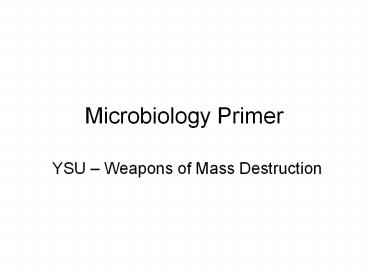Microbiology Primer - PowerPoint PPT Presentation
1 / 23
Title:
Microbiology Primer
Description:
Microbiology Primer. YSU Weapons of Mass Destruction. Historical ... Identification Why is it difficult to monitor for bioterror real time? Culture. Gram Stain ... – PowerPoint PPT presentation
Number of Views:51
Avg rating:3.0/5.0
Title: Microbiology Primer
1
Microbiology Primer
- YSU Weapons of Mass Destruction
2
Historical
- Biogenesis vs. Spontaneous Generation
- 19th Century Golden Age
- Germ Theory
- Pasteur
- Koch
- Lister
3
Classification
- Animalia
- Plantae
- Fungi
- Protista
- Monera
4
Comparison
- Eucaryotic
- Nuclear Membrane
- Diploid DNA
- Mitosis
- Organelles Present
- Simple Cell Wall
- Procaryotic
- No Nuclear Membrane
- Haploid
- No Mitosis
- Organelles Absent
- Complex Cell Membr.
5
Procaryotic Organism
6
Bacteria
- 0.5-6 ?m (human hair is about 90 ?m)
- Simple Stapylococcus is 1.2 ?m
- Shape
- Coccus
- Bacillus
- Spirillum
- Spirochete
7
Useful Bacteria
- Acetobacter vinegar
- Lactobacilli yogurt, cheese
- Actinomyces antibiotics
- Others
- Industrial alcohols, acids, enzymes, rubber and
plastics
8
Pathogenic Bacteria
- Grp A Strep
- B. pertussis
- S. aureus
- H. influenza
- Kl. pneumoniae
- L. pneumophila
- M. pneumoniae
- Salmonella typhi
- Plague
- Cholera
- Typhus
- Anthrax
- Q-Fever
- Clostridium
- Tularemia
- Glanders
9
Bacteria
- Group Patterns
- Cell Membrane
- Gram Positive
- Gram Negative
10
Bacteria
- Endospores
- Significance
- Sporulation is important in Bacillus
Clostridium species. - Botulism disease
- B. anthracis
11
Bacteria Reproduction
- Binary fission
- Daughter cells
- Population doubles each generation
- Phase (important in disease)
- Lag
- Exponential
- Stationary
- Death
Day 1 Day 3 Day 5 Day 7
12
Similar Organisms
- Rickettsiae
- Gram negative
- Difficult to stain
- Grow in living cells
- Treatable with antibiotics
- Q-Fever
- Rocky Mt. Fever
13
Viruses
Modern antibiotics cannot kill viruses. In
fact, questions still exist as to whether viruses
are actually alive.
Orthopox vaccinia
14
Viruses
Name that virus. . . .
15
Viruses
- Submicroscopic
- 0.02 - 0.3 ?m
- Either DNA or RNA
- Glycoprotein envelope
- Obligate parasite
Rhinovirus 14
16
Viral Reproduction - RNA
- Replicates in cytoplasm
- Capsid dissolves
- RNA acts as messenger
- Cell systems harnessed for replication
Poliovirus at 350K magnification
17
Animal Cell
18
Prions
These are, in fact, incomplete shreds of protein
whose origin are unknown. They can insert
themselves into the genetic code of healthy cells.
- BSE 1986, also classified as a transmissible
spongiform encephalopathies. - vCJD
19
Other Organisms
- Amoeba
- Flagellates Protozoans (dinoflagellates)
paralytic shellfish poisoning - Plasmodium (malaria)
20
Nutritional Patterns
- Saprophytic
- Live on dead organic material
- Holozoic
- Ingest solid food
- Parasitic
- Nutrients at expense of host
- Obligate Parasite
- Requires host for specific function
21
Fungi
- Saprophytic
- Some produce mycotoxins
- Coccidioides imitis
- Histoplasmosis
- Crypotcoccus neoformans
22
Identification Why is it difficult to monitor
for bioterror real time?
- Culture
- Gram Stain
- Direct Mount
- Enzymatic Identification
- Microscopy
- PCM, Bright Light, Fluorescence
- PCR
23
Biological Toxins
- S Enterotoxin B
- Botulinum toxin
- Mycotoxin (Tricothecene or T2)































